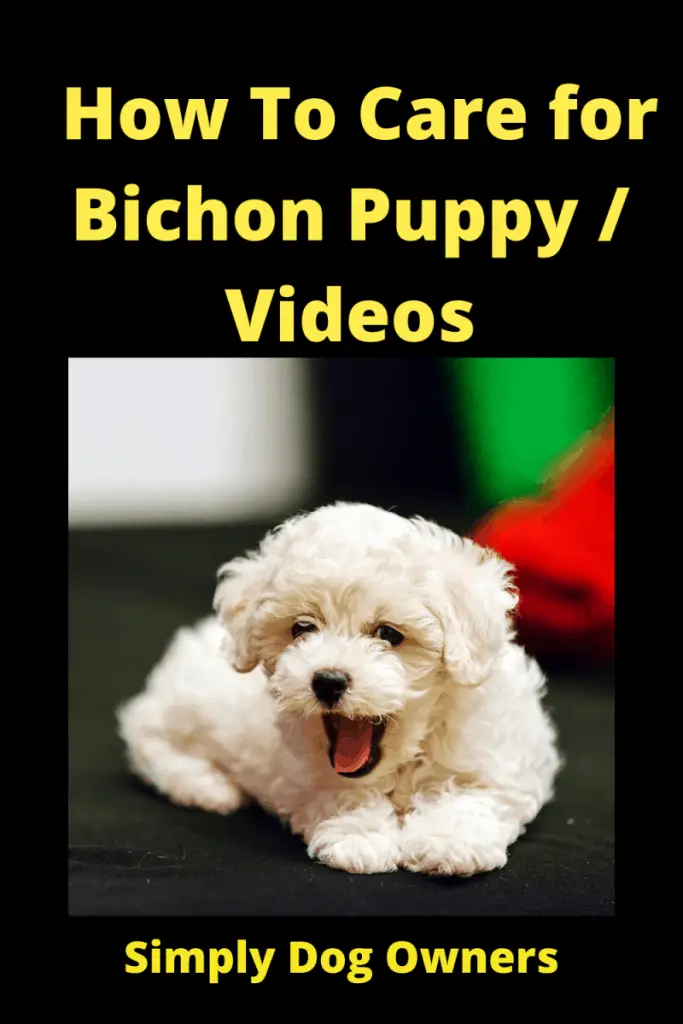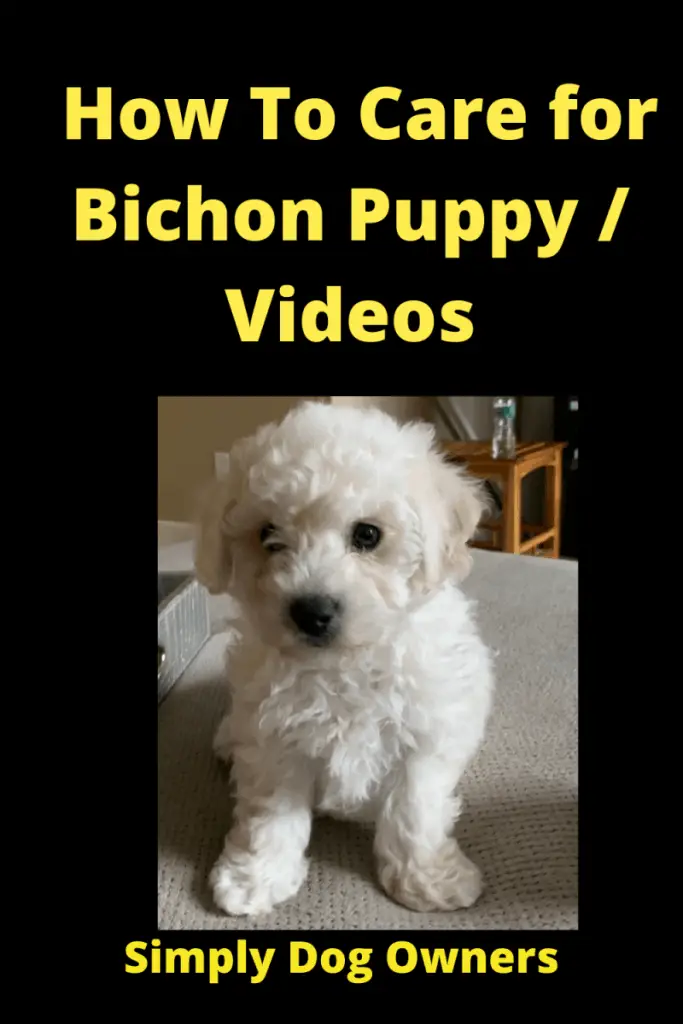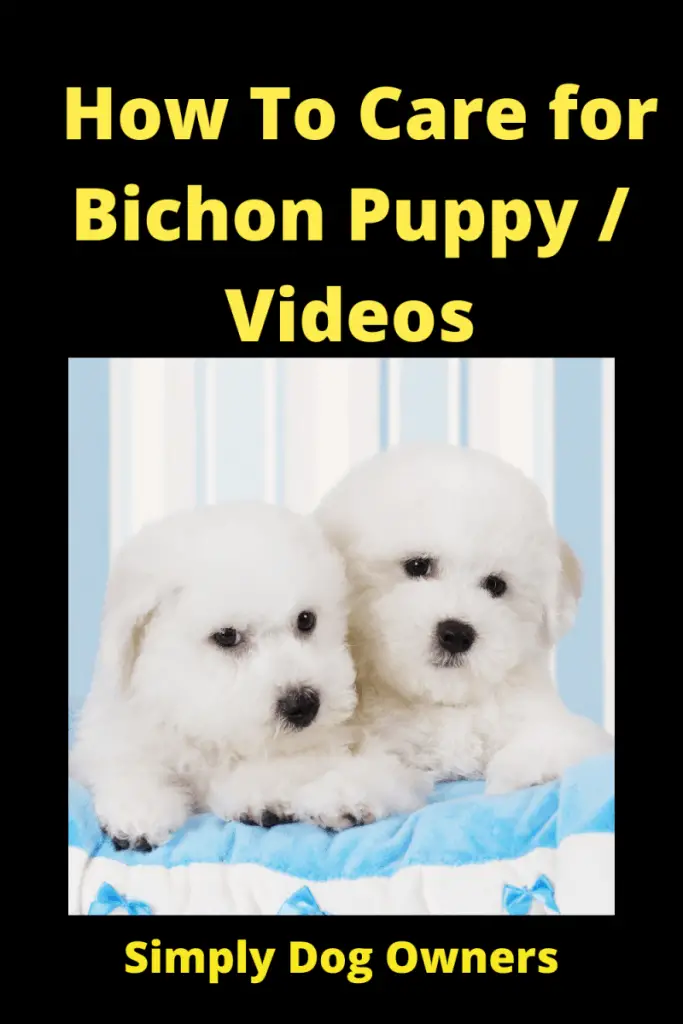Bichon Frise puppy care takes a little time and effort, but it will be worth every minute! Bichons need extensive grooming, but they are otherwise easy to care for. Just as getting ready for a new baby takes some thought and planning, getting ready for your new puppy will require some preparation as well.
Puppy Proofing Your House
- Provide Chew Toys / Bones / Puppies Teething
- No Free Electrical Cords
- Cage for him to Stay in
- Pee Pads – Taking the Little Guy out immediately after Meals
- Protecting him from Stairs
- We used Child gates to keep them safe
- Watch the Little Guy with Kids /. They are Babies
- Protect Trash
- Keep from Chemicals – they love to chew
- Remove any Lead-Based items they can chew on
- Container to limit food amounts / Keep away from people food
You will need to puppy-proof your home and purchase some basic equipment before you go to get your new Bichon Frise puppy. Taking time to care for your puppy and to teach her manners and obedience, is well worth the effort! The thrill of getting a new puppy is sometimes dampened when you get your puppy home. Panic sets in as you wonder what to do next.

Taking care of a new puppy is lots of fun, and it can also be a lot of work! But, once you get the hang of it, you will bond with your new puppy and enjoy many good times together. Bichon Frise puppy care, while important, is not difficult when you know what to do, Basics of Bichon Frise Puppy care. As a new Bichon Frise puppy owner, you will have some responsibilities. Here are some of the things that will be your responsibility:
House for your Bichon Frise Puppy
Place a box/basket /cage at a comfortable spot in the house, where he can see some activity from the household. You can also get some fleecy dog rugs to serve as his bedding. Keep in mind that puppies need a lot of sleep, so his bed will most likely become his sanctuary where he can feel safe and secure. Do not confine him out of the house or in a damp garage, as this is not a healthy environment for a puppy.
Remember also your puppy was a member of a family, his litter before he came to your family. So he might, or will be lonely. Keeping him where the action is will go along way in helping your puppy adjust to his new family.
Training Your Puppy
Part of your pet parent’s responsibility is training. A well-behaved Bichon Frise with good manners is loved by everyone. In addition, when your dog is well trained, you can take her anywhere.
The earlier you begin his training, the easier it will be on Both of you. Potty Training is cruical.
Taking your dog with you gives you more opportunities to travel and to enjoy more events and activities. A young puppy is like a baby: he does not have self-control. Take him out in the morning before doing anything else, after every two hours during the day, and in the evening before going to sleep.

Also, we found that as soon as he is finished eating, he will need to relieve Himself. Easy to remember – Something goes in something comes out.
When it’s time to relieve himself, take him to the designated area and wander around until he’s done. Don’t play with him while he’s conducting his business. Praise him when he’s accomplished the mission. Until he is successfully housetrained, spread newspapers around his bed. Steer away from shouting or punishment as this will only make him nervous. Some dogs can become so trained they will try to pee on command. This is a very good trait to develop.
Your Puppy’s Health and Safety
When the weather gets too hot or too cold for your puppy, you will need to help him out. You may have to provide a way to keep him comfortable. To keep your puppy safe, you may have to consider fencing. And even the healthiest puppy can eat something bad for him or get sick occasionally.
When our litters were tiny, we used a octogon child pen for our puppies. This allowed us to keep them safe, also alowwed us to move it to fresh grass after they have soiled it. You Need to keep your Puppy safe from
- Theft / We Microchipped Our Dogs
- Weather – Cold and Rain – They are babies
- Owls and Hawks – They will fly down and take your Puppy for a easy meal
- Young Children Being too rough
- Dog Diseases – Especially until they have completed all shots and Boosters
- Getting Lost – They will wander playfully away and not be able to find their way home
- Depending on Age, Puppies Getting too cold is life threatening

Routine Puppy Care
Some things are just routine, and all dog owners do these things. Your puppy will go through teething and other puppy stages as she matures. But do not forget that you’ll want to spend some special fun time with your new puppy.
You can even provide him with little toys like stuffed animals. So, if you are very busy and will not have much time to spend with your dog, a Bichon Frise may not be the dog for you. On the other hand, if you can spend some quality time each day with your Bichon puppy, you will be rewarded by the companionship of a true friend, who really loves you!
Some owners when they bought one of our puppies, they actually purchased two, so they each would have a brother or sister for companionship.
When & How to Feed Your Bichon Frise Puppy
Feeding your Bichon depends on its age. Puppies and adults eat at different hours and must follow different food portions. Bichons Frises eat one cup of meal a day. Puppies that have just left their mother or have been weaned must be fed four times a day with 5-hour intervals between feeds. The food must be divided into 1/4 cups and should follow a routine schedule similar to the one below:
- 1/4 cup after waking up and taking their walk
- 1/4 cup midday
- 1/4 cup late afternoon (5-6 P.M.)
- 1/4 cup in the evening
Puppies always start teething. Therefore, give your Bichon crunchy treats, bones, and dental treats. The crunchy exterior will make their teeth grow, develop strong enamel, and keep their gums clean. Follow a similar program below:
Ten Weeks Old
- 1/3 cup 6-8 A.M.
- 1/3 cup midday
- 1/3 cup 6-7 P.M.
A Year Old
After your Bichon reaches a year old, he/she will lose interest in the midday meal. Follow a similar program below:
- 1/2 cup when they wake up
- 1/2 cup in the evening
Brushing & Grooming
Before you decide on adopting a Bichon Frise, you must decide whether you can commit to daily brushing and grooming. Bichon Frises are known for their elaborate, massive white puffy head and legs.
Their hair grows fast and long and requires to be brushed. If you don’t have time to learn and master the grooming techniques, then decide whether you can afford the monthly visits to the groomer. Groomers usually bathe your Bichon, clean the hair inside the ears, trim the nails, clean the anal glands, clean the eyes, cut, and trim your Bichon to look like their puffy self.
Grooming can be expensive. We get a very good price, but our good price is $40 for each dog.
Daily brushing includes combing through their coat in order to prevent their hair from matting. Some Bichons love water and love to get wet. I have a theory that Bichon Frises do their best to get wet so they have an excuse to get brushed and blow-dried. If you start the daily brushing when your Bichon Frise is a pup, your little one will come accustomed to it and look forward to getting brushed.
Using a pin brush helps remove the small knots the brush does not pick up. Keep in mind that if you don’t brush their hair, their coat will get matted and pull on their skin. This is equivalent to you growing your hair, never brushing it, and then trying to run a comb or brush through it. If it hurts you, then you can bet it hurts your Bichon.
Brushing and combing at home
Because shed Bichon Frise hair doesn’t fall out of the coat, it becomes caught up in the rest of their fur which can quickly lead to tangles, knots, and matting if you don’t keep on top of things. This means that your Bichon Frise will need to be brushed and groomed more or less daily, and you should begin doing this with your Bichon puppy more or less as soon as you bring them home so that they get used to it and accept the process.
A comb with a pointed end and a pin brush is the best tool to use, and you should ensure that these tools are the appropriate size for your dog and not too large. If you brush your Bichon daily knots and mats won’t get a chance to develop, and it is important to comb your dog’s fur right down to the skin, and don’t miss tricky areas like the insides of the legs and under the belly as these areas, in particular, are prone to matting up.
If you do come across a knot or mat that won’t brush out, the first step is to split and divide it so that it’s loose from the skin, before working it out entirely. Your comb and particularly, the pointed end of the comb is the best choice for this job.
Bathing Bichon Frise Puppy
If your Bichon Frise goes to a groomer every couple of months, you are unlikely to need to bathe them at home in the interim. However, if you take care of all your dog’s coat care needs at home, bathing is something you should undertake regularly, alongside your regular brushing and grooming routine.
Before you bathe your Bichon Frise Puppy, brush their coat out thoroughly as their hair will stretch somewhat when wet, making it more prone to pulling and breaking when you do brush it. The water can also tighten the curls in your dog’s coat, making it harder to remove mats and knots. Dry your dog’s coat thoroughly after their bath, ensuring that it is dry right down to the skin and not just on the top layers, and brush it as you go.
Grooming, Clipping, and Trimming
Most Bichons visit a groomer regularly to take care of their bathing and clipping or trimming to give them their distinctive neat and tidy hairstyle. This may involve clipping a lot of their coat off to achieve a short, easy to care for the style or simply trimming it to keep it neat but rather longer.
Whether your dog’s coat is trimmed or clipped, the finishing touches and fine detailing will need to be achieved manually with scissors, to produce the rounded curves that are the signature of the breed’s coat, and to remove some of the often thick, wiry fur between their toes.
The groomer may also thin out some of the hair on the insides of their ears too and tidy up your dog’s beard to make them look neat and because the Bichon beard often traps a lot of food and muck!
The Correct Texture for the Bichon Frise Coat
Bichon Frises have a double-layered coat, with the topcoat being comprised of the slightly coarse curls that give the breed their appearance, and a soft, very dense undercoat beneath this that provides volume.
While the topcoat itself should feel slightly coarse, it should never be brittle or wiry, or too silky and smooth. If the curls of the topcoat aren’t brushed regularly, they will form very tight curls, which are prone to knotting and that produce a rather different appearance to the wavy, fluffy coat that is the breed’s signature. If your Bichon’s topcoat is noticeably curled in defined sections, they need to be brushed out!
Top 10 Bichon Designer Breeds / Parents /Size / Video
| Designer Mix | Parents | Size | Video |
|---|---|---|---|
| Maltichon | Bichon / Maltese | Height / 8-11 inches Weight / 8 - 13 lbs | Maltichon |
| Bichpoo | Bichon / Poodle | Height / 9 - 14 inches Weight / 6 - 9 lbs | Bichpoo |
| Shichon | Bichon / Shih Tzu | Height / 9 - 12 inches Weight / 10 - 15lbs | Shichon |
| Yorkie Bichon | Bichon / Yorkie | Height / 9 - 12 inches Weight / 6 - 8 lbs | Bichon Yorkie |
| Chi Chon | Bichon / Chihuahua | Height / 8 - 10 Inches Weight / 6 - 10 Lbs | Chi Chon |
| Kashon | Bichon / Cairn Terrier | Height / 9 - 15 Inches Weight / 10 -18 Lbs | Kashon |
| Goldichon | Bichon / Golden Retriever | Height/15 - 20 inches Weight /20-40 Lbs | Goldichon |
| Chonzer | Bichon / Miniature Schnauzer | Height /10-16 inches Weight / 25-35 lbs | Chonzer |
| Glechon | Bichon / Beagle | Height /15-16 inches Weight / 15-35 lbs | Glechon |
| Corgi | Bichon / Corgi | Height /11-13 inches Weight / 31-37 lbs | Corgi |
Name - Link for Research
Parents - Breeds of Dogs
Size Height / Weight
Video - Video of the Bichon Designer Breed
Chart of Bichon Birthing Accessories
| Breeder Box | Do Not used Wired Dog cage |
| Heater | We use space heater for whole Room |
| scale | To Weigh Puppies make sure they are Gaining Weight |
| Clean towels | Chande during Birthing to clean up |
| Protected Space | Keep Mother away from other Dogs to avoid Distress |
| Draft Protection | Drafts can chill and kill a Puppy |
| Squash protection | Mothers can accidently squash a puppy |
| clean bedding | to replace after birth - will be wet |
| Seclusion | Needs her Privacy - she can get Hyper |
| Rubber Gloves | Keep things Clean and from Blood |
| Scisorrs & Thread | For Cutting Cord |
Puppy Birthing Complications
| Complications | Steps |
|---|---|
| If Unsure | Take to Vet If Time allows |
| Keep Mother Isolated | If Other dogs around she could get defensive and accidently Hurt Puppies |
| Puppy Accidentally Crushed | Make sure Not Giving Birth in Dog cage - puppies can work themselves through mesh and get Damaged |
| Not Breathing | Gently Give it Mouth to mouth |
| Not breathing | Massage Puppy trying to gently force fluid from his lungs |
| Puppy Stuck | Gently Pull |
| Puppy Breech | Help Guide legs out |
| Puppy Cold | Raise Enviorment to 85 degrees |
| Puppy Cold | Change Wet Bedding |
| Puppy Cold | Warm Puppy up put on Your body till body heat warms him |
| Puppy Cold | No drafts - No metal Floor Pan on Cage |
| Puppy not going on Nipple | Help Guide him to nipple till he gets hand of it |
| Puppy not feeding | Try Small baby Bottle let him suck - do not force him - can drown him with milk going in lungs |
| Puppy not feeding | Use puppy Milk Supplement |
| Puppy Not feeding | check for Cleft Palate |
| Puppy Not Feeding | Take to Vet - he can show you Catheter Feeding |
| Puppy Not Growing | Make sure Mother has plenty Food Water |
| Puppy Not Growing | You can check on scale |
| Labor stops or is prolonged over 24 hours | Take to vet - C section can save litter and Mother if needed |
| Mother does not Remove Membrane | You will Need to Manually remove it |
| Mother does not chew through Umbilical Cord | You will need to cut it 1/2 " away from puppies body tier with thread |
And Recommended Steps
Expense Table for Owning Bichons Frise
| Average Cost of AKC Puppy | Puppy Shots | Food | Grooming 4 / per year | Cage / Accessories / Bowls / Brushes / Leash / Collar | AKC - Registration Within 6 Months of Purchase | Micro Chip | Yearly Meds Heart Worm Worming | Dog License | Total Investment | Puppies Possible / Year |
|---|---|---|---|---|---|---|---|---|---|---|
| $ 450 - No Breeding Rights | $ 120 | $ 10 / Wk High Quality Food | $ 45 ea / $180 Yr | Cage - $50 Rest - 50 | $ 35 | $ 45 - One Time Cost By Vet | Heart Worm Meds - $60 / Yr Worming - $ 30 / YR | $ 35 / Yr | $ 1575 / Dog | 1-6 Puppies Average 3 |
| $ 750 - $ 950 Puppy with AKC Papers and No Restrictions | Total Investment | |||||||||
Breeds Descended from Water Dogs
| Name of Breed | Country of Origin |
|---|---|
| American Water Spaniel | United States |
| Barbet | France |
| Cantabrian Water Dog | Spain |
| English Water Spaniel | England |
| Irish water Spaniel | Ireland |
| Lagotto Romagnoio | Italy |
| Poodle | Germany |
| Portuguese Water Dog | Portugal |
| Pudelpointer | Germany |
| Spanish water Dog | Spain |
| Tweed water Spaniel | England |
| Wetterhoun | Netherlands |
Bichon Frise Resource Links
| Bichon Frise Club of America | United States | Link |
|---|---|---|
| Bichon Frise AKC | United States | Link |
| Bichon Frise United Kennel Club | UK | Link |

